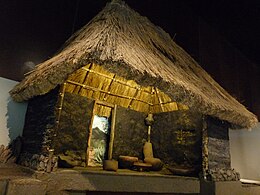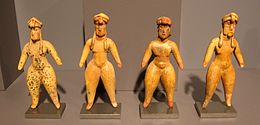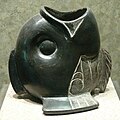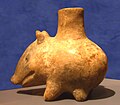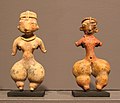Tlatilco culture
The Tlatilco culture is named after the suburb of Tlatilco , west of Mexico City . So far, three sites are known that are assigned to this culture: Tlatilco, Tlapacoya and Coapexco .
geography
The three places mentioned are all on the former lagoon lakes in the vicinity of Mexico City at altitudes of around 2300 m above sea level. d. M. and were only noticed relatively late by archaeological research, as nothing could be seen above ground, because buildings or other stone objects (e.g. steles or altars) were unknown. The lagoon lakes, however, offered sufficient water all year round; their banks were fertile and also attracted game and birds that were hunted.
Living conditions
It is assumed that the creators of the extraordinary clay figurines lived in one-room reed huts - reinforced with wooden poles - the outer walls of which were pelted with clay for better insulation against the winter and nocturnal coolness. In addition to hunting, they lived on fishing and farming ( corn , beans , tomatoes , chilli, etc.) - perhaps even on floating cultivation areas ( chinampas ). Draft animals to help with field work and the processing of metals were unknown; only obsidian knives and scrapers were used.
history
The Tlatilco culture is the oldest culture in the central Mexican highlands, of which significant artifacts in the form of - mostly hollow - clay figurines have been preserved. They are mostly found in the period between 1500 BC. BC and 1000 BC Dated and associated with artistic influences from the Olmec cultural area. Many of the finds come from robbery excavations in the 1930s and 1940s and are in American and Mexican private collections - some of the objects are only gradually making their way into museums.
Found objects
The mostly fully plastic figurines , of which about 200 are known so far, were all found in graves and are therefore neither to be regarded as everyday objects nor as cult objects. They were probably designed from the outset as finely crafted grave goods (cf. Jaina ). They testify to an extraordinary gift of observation and a high level of craftsmanship of their creators. There are both female and male sculptures - animals and abstract motifs also play a major role. There are no depictions of gods and / or rulers or priest-kings, which suggests a rather small-scale, village social structure. Some of the clay figures show strange deformities such as B. two heads - whether these can also be traced back to observations of nature or the imagination of their creators is unclear.
photos
Vessel in the shape of a peccary
See also
literature
- David C. Grove: La Zona del Altipiano Central en el Preclásico. In: Linda Manzanilla, Leonardo Lopez Lujan, Miguel Angel Porrúa (eds.): Historia Antigua de Mexico. Mexico City 2000, pp. 511-542.
- Christine Niederberger: Ranked Societies, Iconographic Complexity and Economic Wealth in the Basin of Mexico toward 1200 BC. In: John E. Clark, Mary E. Pye (Eds.): Olmec Art and Archeology in Mesoamerica. National Gallery of Art, Washington / Yale University Press, New Haven 2000, ISBN 0-300-08522-2 , pp. 169-191.

